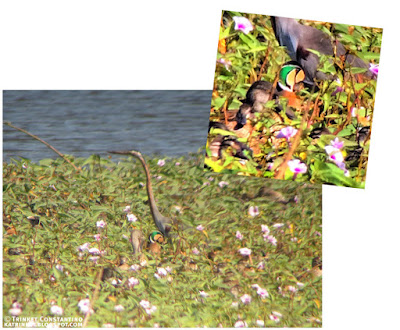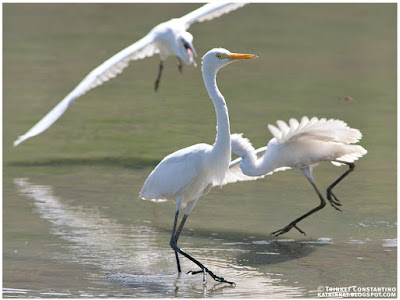Exciting times again for Candaba, after last year's Baer's Pochard.
With Adri out on tour, I was happy to tag along with Tere, Alex and Drew to twitch the country rarity. Meeting us there were Tina and Neon ready with their bazooka lenses. Mads and Jude were also following. A daily stream of visitors kept us up to date on the sightings, it was obviously a big deal to the local birding community to have two new country records at a very accessible location.
When we arrived, the plains and ponds were just being lit up by the golden morning light. In front of us was the remaining pond, filled with thousands of ducks: mostly the endemic Philippine Ducks, some resident Wandering Whistling Ducks, and the migrants of course: Garganey, Northern Shovellers, Northern Pintails, Eurasian Wigeons, Green-winged Teal, Tufted Ducks. The challenge was on to find a single Baikal Teal and a single Falcated Duck.
 |
| This pond is where we had to find the ducks. |
As we surveyed the ponds, every now and then a flock of Black-winged Stilts would take to the air, elegant and graceful as ever.
 |
| Black-winged stilts in flight. |
The skittish Philippine Ducks would also suddenly lift off noisily from the water's surface, joined by a few migrants. They would circle the ponds and land again, with just as much splash as they made taking off.
 |
| A frenzy of Philippine ducks. |
A Eurasian Coot swam quietly near us.
 |
| This coot was quite close. |
We were all quietly concentrating on looking at each and every duck (something we really should do, even without specific target in mind: that's how unusual sightings are made!).
And then, in a sea of fl0ating kangkong leaves and blossoms, a brilliant emerald green suddenly popped out. It was the Baikal Teal!
 |
| Can you spot the Baikal Teal in this photo? (See the close-up below) |
 |
| A beautifully plumaged duck: the Baikal Teal in the floating vegetation. |
It was quite a distance away, thankfully it was in the vicinity of a small bahay kubo in the middle of the pond, which made it easier to point out to the others.
 |
| The teal was somewhere here. |
Yay!
Watch this short video in HD (click play then the gear on the bottom to change quality to HD). Thanks to Alex for sharing this i-phone-scoped video!
It was busy preening itself, so every now and then its head would disappear into the kangkong. Later it would even go to sleep, its head tucked under its wings.
 |
| It became even harder to spot when it tucked its head in to sleep. |
It's a good thing it had a very distinct head pattern and color, which made it easier to spot once you knew its general location.
 |
| Here it is! |
Later it would move around, never flying up but paddling across the pond or flying low short distances. As long as we kept our eye on it from time to time, it was easy to keep track of it or even to find it again.
 |
| It moved about in the kangkong, mostly half hidden with only its head sticking out (thanks to Drew for the enhanced i-phone-scoped photo on the corner!) |
High fives and thumbs up all around!
 |
| Birders and photographers enjoying the Teal, even if it was quite a distance away. |
As we were observing the Teal, suddenly an Eastern Marsh Harrier showed up, spooking most of the ducks into the air (but thankfully not the teal).
 |
| A majestic aerial display by an Eastern Marsh Harrier. |
While we were watching the aerial display, Mads suddenly exclaimed: "Nakita ko na sya!" ("I've spotted it!") referring to the Falcated Duck.
Scopes, cameras and bins suddenly zoomed in on to the general location Mads was pointing to, which was even further than the location of the Teal!
 |
| The Falcated Duck is somewhere here, with some Philippine Ducks and Northern Pintail. |
Sure enough, swimming with several Philippine Ducks was the target. It was a handsome duck, with a deep chocolate, head which glossed a bright green under the sun. It had a white throat and spot at the base of its beak.
 |
| The Falcated Duck was busy preening, it's green glossy head shimmering in the sunlight. |
Like the Teal, it was busy preening itself, and every know and then we could see the curved feathers on its side and back after which it was named.
Yay again!
A short video of the Falcated Duck, thanks to Tere for sharing this i-phone scoped video! (Remember to watch it in HD)
It's great to have had the chance to observe these new country records. We couldn't use our normal Kennedy field guide as it didn't have these species' descriptions, so we had to refer to other field guides.
 |
| No Kennedy guides were used that morning! |
These sightings once again highlighted the need to preserve the remaining wetlands of Candaba which have all but been converted to great swathes of rice fields to feed the burgeoning population. The earth that feeds and shelters us needs to feed and shelter those we share it with too.
Mads writes about the latest Candaba sightings and a new initiative to save its remaining wetlands here: http://www.gmanetwork.com/news/story/551976/scitech/science/various-rare-birds-spotted-in-candaba.













































